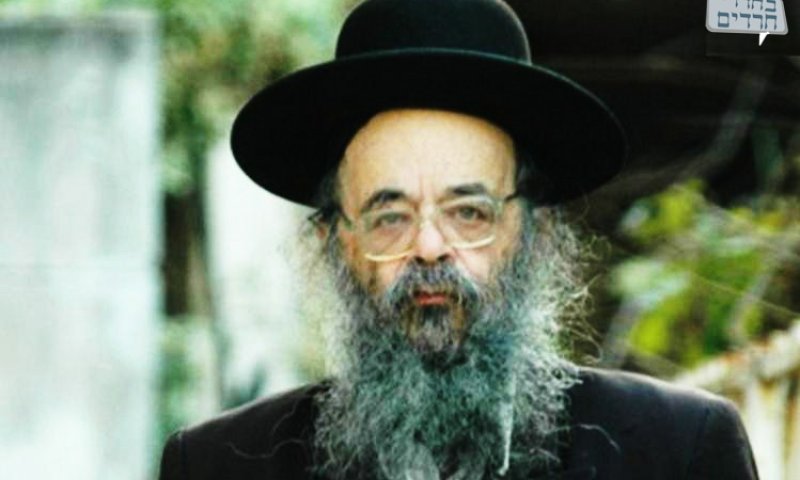
Hgr"d Shmidel: "There are burial lots according to Jewish custom"
Thought bulldozers are on their way to the Golobnzitz compound? The rupture within the "Adah" - depth • chairman of Atra Kadisha writes in a letter: "All doubts in burial lots came from special interests •" Full letter
- Yaki Adamker B'Chadrei Charedim
- כ"ט תשרי התשע"ג

Hgr"d Liddell. Photograph: Archive
"Of course they are burial lots," stated Hgr"d Shmidel, Chairman of the 'Atra Kadisha, in a long and detailed letter sent to The Adah Charedi Av Beis Din - Rabbi Weiss addressing the issue of graves in the Golobnzitz compound in Beit Shemesh.
The letter which is revealed for the first time first brings the organization's main arguments which many have accused of it delaying the ongoing construction site. Over a four-page spread letter Hgr"d solicited arguments before Harav Weiss as he tried to explain that the struggle is the desecration of graves and should not be seen as "unnecessary."
Many will say that the letter is in response to a letter written by the Rav Av Beis Din - Reb Moshe Sternbuch exposed for the first time, which held that one can go up to the area and begin construction with a tractor immediately.
"Some basic points about the test excavations of burial lots in Beit Shemesh – a place called "Hills of Jerusalem", opens Hgr"d in his letter. "Are these tests beneficial, and may we make them now and what has been found to date."
In his first section, writes Rabbi Shmidel: "Of course they are burial lots, there is no doubt and no argument in this, for all who know about it. All misgivings and doubts were only on the part of people with personal interests and maybe some people who do not have any experience in this area."
Are these Jewish graves? "There is no clear evidence, but in any case these burial lots are according to Jewish custom burial."
Is it possible that during trial excavation it turns out that these are not Jewish graves? The bones are in a state of disintegration. If there are photographers or other tools that are not according to Jewish custom it may give evidence about the grave and even the neighboring graves, but so far we have not found any evidence in the graves that were opened. If non Jewish tools are found it will delay construction maybe even a delay of years "
What was found in tests made so far?" The first grave found several human bones," writes Hgr"d Liddell. "Landowners, their assistants and archaeologist hired by them immediately stopped the test, despite The Rabbi's orders to continue. They prevented more digging because they feared they would find more bones. In other graves they did not reach the bottom of the grave where the bones are placed."
Later in the letter Hgr"d explains the difficulty in examining the construction site of graves, "when bones that are placed in the graves are in decay, it is difficult to distinguish them, Sometimes, inBet Shemesh included, the color of the bones cannot be distinguished from the color of the soil. When digging a grave for its examination by the time you notice the bones you have hit a little and this includes even when the digger fears sin. "
The letter which is revealed for the first time first brings the organization's main arguments which many have accused of it delaying the ongoing construction site. Over a four-page spread letter Hgr"d solicited arguments before Harav Weiss as he tried to explain that the struggle is the desecration of graves and should not be seen as "unnecessary."
Many will say that the letter is in response to a letter written by the Rav Av Beis Din - Reb Moshe Sternbuch exposed for the first time, which held that one can go up to the area and begin construction with a tractor immediately.
"Some basic points about the test excavations of burial lots in Beit Shemesh – a place called "Hills of Jerusalem", opens Hgr"d in his letter. "Are these tests beneficial, and may we make them now and what has been found to date."
In his first section, writes Rabbi Shmidel: "Of course they are burial lots, there is no doubt and no argument in this, for all who know about it. All misgivings and doubts were only on the part of people with personal interests and maybe some people who do not have any experience in this area."
Are these Jewish graves? "There is no clear evidence, but in any case these burial lots are according to Jewish custom burial."
Is it possible that during trial excavation it turns out that these are not Jewish graves? The bones are in a state of disintegration. If there are photographers or other tools that are not according to Jewish custom it may give evidence about the grave and even the neighboring graves, but so far we have not found any evidence in the graves that were opened. If non Jewish tools are found it will delay construction maybe even a delay of years "
What was found in tests made so far?" The first grave found several human bones," writes Hgr"d Liddell. "Landowners, their assistants and archaeologist hired by them immediately stopped the test, despite The Rabbi's orders to continue. They prevented more digging because they feared they would find more bones. In other graves they did not reach the bottom of the grave where the bones are placed."
Later in the letter Hgr"d explains the difficulty in examining the construction site of graves, "when bones that are placed in the graves are in decay, it is difficult to distinguish them, Sometimes, inBet Shemesh included, the color of the bones cannot be distinguished from the color of the soil. When digging a grave for its examination by the time you notice the bones you have hit a little and this includes even when the digger fears sin. "
תגובות
{{ comment.number }}.
הגב לתגובה זו
{{ comment.date_parsed }}
{{ comment.num_likes }}
{{ comment.num_dislikes }}
{{ reply.date_parsed }}
{{ reply.num_likes }}
{{ reply.num_dislikes }}



הוספת תגובה
לכתבה זו טרם התפרסמו תגובות